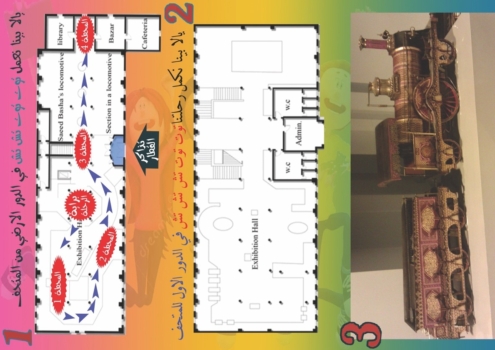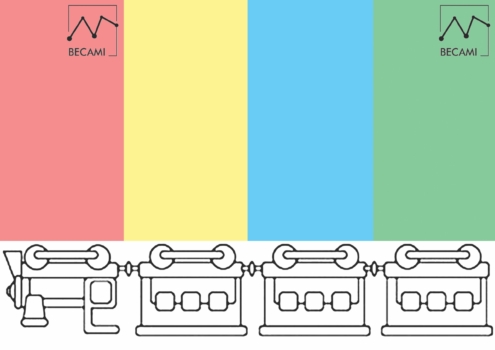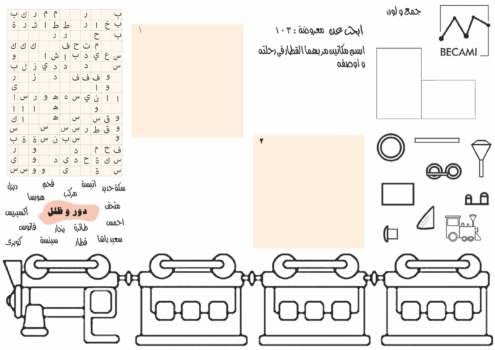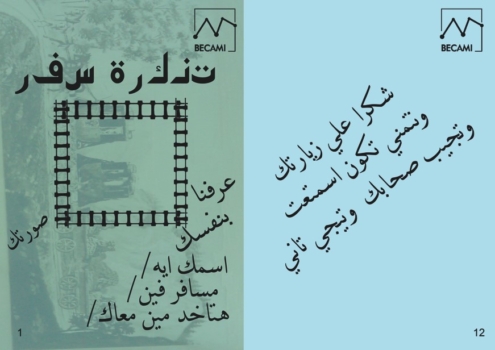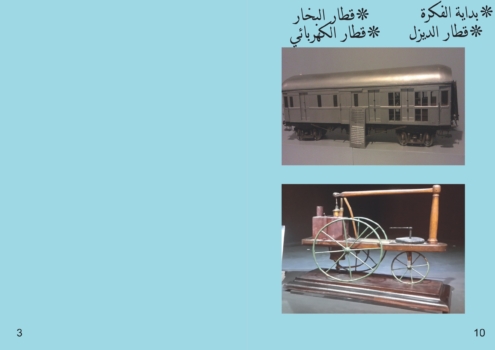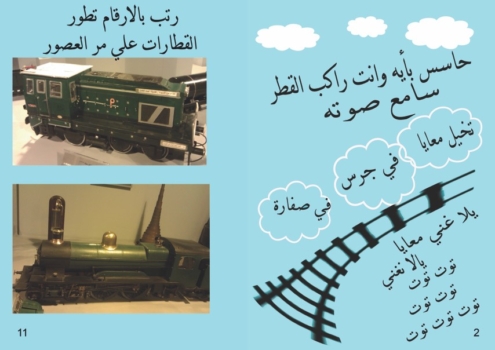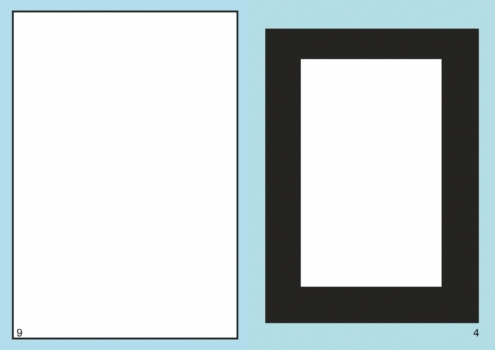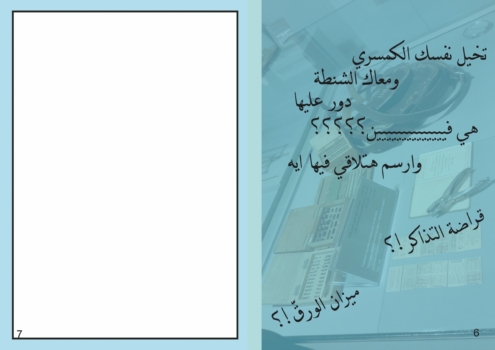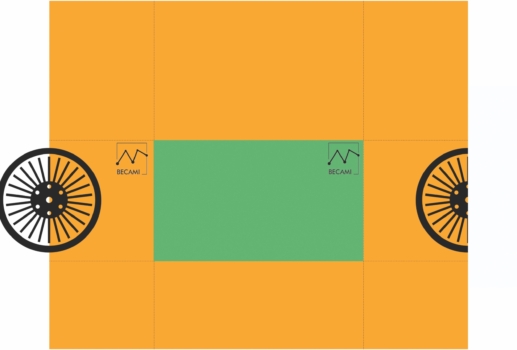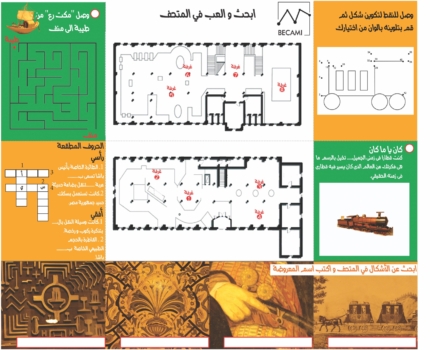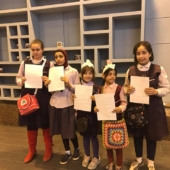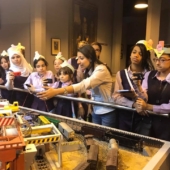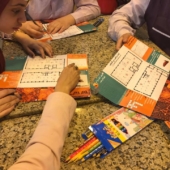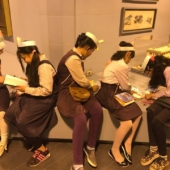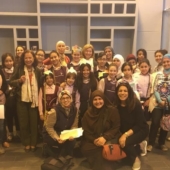The third workshop was held at the campus of the French University in Egypt, from the 10th to the 12th of April 2017. The Egyptian Railway Museum was selected to be the focus of the workshop. Participants were invited to design activity cards and publicity materials for school children aged 7 to 11 years, to engage them with the museum’s collection.
| BECAMI organizing team: | Prof. Galila El Kadi (Principal investigator, Egypt) |
| Dr. Gehan Selim (Co-Investigator, UK) | |
| Dr. Doaa Abouelmagd (Co-investigator, Egypt) | |
| Dr. Eman Abdou (Researcher, Egypt) | |
| Mrs. Sohailah el-Sawi (Partner, Egypt) | |
| Reem Elsawaf(Architect Researcher, Egypt) | |
| Mahy Hamed (Architect Researcher, Egypt) |
Aims of the workshop
BECAMI third workshop was planned and organised in response to the following objective: To co-produce art installations and publicity material for each of these museums by engaging school children and university students through workshops, hence facilitating emotional ownership for these museums.
The vision of BECAMI is to engage and reconnect the younger generations with an important historical period during which Egypt was leading a renaissance in the Arab world. During the workshop, university students and school children participated in the re-discovery and emotional appropriation of the Egyptian Railway museum. Since there are no children games, or leaflets designed for children in Egyptian Museums, the workshop aimed to explore the possibility of designing activities that target students and children, to engage them with the museum’s collection.
Why Selecting the Egyptian Railway Museum?
The Egyptian Railway Museum was selected as it is one of the best places to stimulate children and make them aware of their history and heritage. The Museum was established in 1933, when Egypt was celebrating nearly 80 years after the inauguration of the first railway line between Cairo and Alexandria. It is a good venue to introduce children to Modern Egypt as the railway is a modern way for communication and movement, which is a witness on technological development. Children can also learn about the development of transportation and communication since the ancient age up to the modern time. They can see detailed models of trains, stations, bridges, and tunnels. They can also see real models of train wagons and the famous people who first used it for travel. They can learn about the role of trains in transporting people and goods in the time of peace, soldiers and wounded people in times of wars and troubles. In addition, trains are very significant for the collective memory of children, who start playing with them as early as the age of two. Train sets are the most popular games for children around the world, which vary based on age, skills and interest. It may take a while for them to learn the system, but the outcome contributes in the development of their motor skills. Furthermore, interconnecting train sets, enhance their creativity and imagination.
Preparing the Workshop
An open call was launched on the BECAMI FB page, with the aims of the workshop, the program, the targeted participants and a brief about the expected engagement: “Selected participants will be divided into groups to create activities, design activity cards and publicity materials for school students aged 7- 11 years, to engage them with the railway museum.” Interested participants were asked to send CVs and letter of motivation. Students were selected based on their professional progress, and their skills in photography and photoshop. Ms. Sohailah El Sawi (EADC, Egyptian Association for Development and Community Engagement) selected the children (from a national school), the teachers and the educators to participate in the workshop. Educators and curators from the museums, taking part in the BECAMI project, were also invited to join the workshop.
Workshop sessions
The workshop participants were invited to create several playful activities. Activities were designed to raise awareness on the valuable collections available at the Egyptian Railway Museum. Activities were purposely designed to encourage school children to interact through games, writing, drawings, sound and movements events.
On the first day, the sessions introduced methodologies used in creating museum activities internationally and to train participants on designing activities inspired by the collection of the Railway Museum. An introduction and two training sessions were presented by the BECAMI team. The sessions discussed creative and innovative approaches and public engagement in the UK. It tackled the ongoing debate around museum’s collections versus engagement and the role of the visitors. It presented various prototypes of activities done in museum engagements, including drawing activities (A viewfinder- Observational drawing activity – Draw and describe activity) Sound and Movement activities – Action games – treasure hunts, designing cards, pamphlets, brochures and various publicity materials for children and students in the museum.
On the second day, the sessions presented similar initiatives implemented in Egypt, to engage school students and children with Egyptian heritage. Two presentations were delivered. The first by Ms. Sohailah El Sawi (EADC) who presented the association’s experience with planning school visits to the Agricultural Museum, and the second by Dr. Heba Safiyeldin (Professor of Architecture in Egypt), who explained how introducing children to their heritage is not only a way to teach them about their history, but also a way in developing their higher intellectual, analytical and artistic skills. Later, the participants were divided into three groups to start the brainstorming. The teams designed cards and publicity materials (leaflets) that include museum activities for school children and students.
Developing engagement activities (university students and school educators). Brainstorming, ideas, feedback and presentations.
During the planning and implementation of the museum activities, a range of factors were explained to the teams to ensure that the children visit to the museum is successful. Students were advised to work in groups to design innovative activity cards, leaflets, and/or publicity material that will engage school students in their visit to the Egyptian Railway Museum. Students were instructed to produce digital outputs to facilitate printing by the end of the second day. The designing process took five hours to be completed. They were advised that each activity should consider the following:
| Purpose | Children to understand the purpose and be rewarded for being engaged in the activity |
| Inclusion | Children need to participate to increase their knowledge, engagement and learning abilities |
| Ownership | They have a natural interest in the museum and its collection, and therefore they feel confident in navigating their way |
| Engagement | To allow participation and engagement in playing activities with children from different age groups |
| Curiosity | Adding a further aspect of curiosity and exploration to the activities e.g. objects hunting |
| Age range | Consider that activities are targeting different age groups and different abilities and skills |
| Time | Allow proper time to discover the museum |
| Use of multiple skills | Such as full body engagement, writing, moving, talking, singing etc. |
Activities in the Museum
The teams presented their outcome to school students the following day at the museum and guiding them through it. All activities included creative ideas for:
| Exploration | The teams incorporated elements of play and exploration in their proposals e.g. ‘Seek and Find’ and ‘hunt for this object’. This increased the children’s motivation and interest in the museum’s collection and history |
| Drawing | Several elements of drawing were added to enhance their experience. It also allowed children to take a closer look at the collections, dates, and narratives of each object |
Team 1: Fun trains and a fun ticket booklet
To see the fun ticket booklet click on the images above
Team 2: Ahlan wa sahlan – Welcome, a train trip through the Museum
To see the game click on the images above
Team 3: Search and play in the museum
To see the game click on the images above
Raising Awareness and Engagement
The workshop’s main challenge was to create a meaningful experience in the museum for the children. The Egyptian Railway museum, with its historical collection of diverse and rare objects, gave the children a first-hand experience with genuine and real objects. The close interaction with the displays offered the children a chance to gain insights, which is not the same when they simply read about it in books. The visit started with an introduction from the Museum’s Director and one of the curators. They provided information about the building, explained its significance, its location and its general layout. Then they took the participants to a chronological tour in the museum. To maximize engagement we aimed to: keep group size small; structure the tour to allow children to follow their own interests; listen to the student’s initial responses; and make the tour a sensory experience (animated train display).
Exploration and playing
The 14 primary/secondary school children (aged between 10 and 12 years old) were divided into three groups. They were supervised by a teacher and an assistant, and were handed their activities to test. Activities were exchanged among the three groups every 30 minutes to maximise the engagement. Rotation was applied to allow all groups to experience and practice all the designed activities. An evaluation was made at the end and after a discussion, the students were asked to vote for their favorite activity. The goal was to identify the best type of activity that increased their awareness on the collection and whether it was easy to hunt and search for the objects. Two questionnaires were given to the participants; one to the students and one to the teachers and the workshop participants. The first activity (Fun Train) received the highest votes, then came in second place the third team activity (A Train trip through the Museum).
| Regarding the first team activity (Fun Train): | “It was the best activity because it included a lot of brain work”, May Emad Eldin |
| “It’s entertaining and promotes thinking”, Mennat-Allah Amr | |
| Regarding the (Fun Ticket) Booklet: | “It’s beautiful because it asks the students to draw trains and the train driver”, Rahma gamal |
| Regarding the second team activity (A Trip by the Train): | ” t’s very entertaining as it made my take a tourthrough all the museum” Sama Khaled |
| Regarding the third team activity (Search and play in the museum): | “It made me learn a lot of information about the museum and the statues in a fun way” Sama Khaled |
Students suggested summer trips for the museum where they will get to play again with the activities, and they wished that there would be a children’s library and a place for acting and drama events at the museum. Mariam Hossam wrote “The creation of more games that promotes intelligence and enhance our information about the museum through walking and activities.”
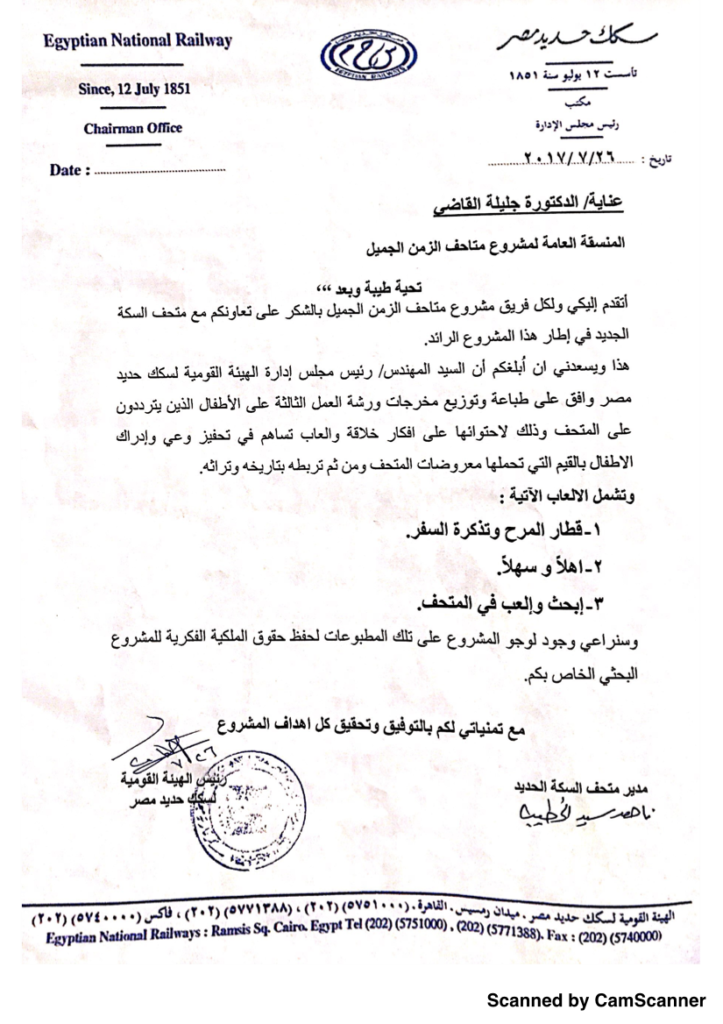
BECAMI received a thank you letter from the Egyptian Railway Museum. The museum is now printing the games and activities developed during the workshop (with BECAMI logo), to reuse with school students during their trips to the museum.



